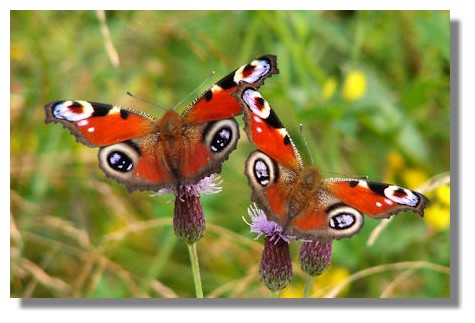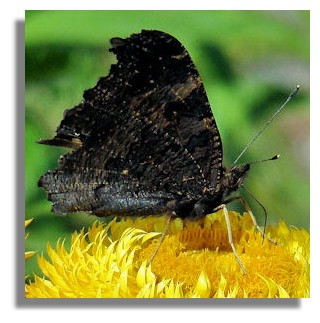
Butterflies of Scotland
- Peacock (Inachis io)

The European Peacock butterfly (Inachis io), is a well-known colourful butterfly, found in temperate Europe and Asia. It should not be confused or classified with the "American peacocks" in the genus Anartia; these are not close relatives of the present species.The Peacock has red wings with black markings and distinctive eyespots on tips of fore and hind wings. The Peacock's spectacular pattern of eyespots, evolved to startle or confuse predators, make it one of the most easily recognized and best known species. It is from these wing markings that the butterfly gained its common name. The Peacock can be found in woods, fields, meadows, pastures, parks, and gardens, and from lowlands up to 8,200 feet (2,500 m). It is a relatively common butterfly seen in many European parks and gardens.
The species is widespread and has continues to expand its range in northern parts of Britain and Ireland but, even so, it is rarer in the far north of Scotland. The peacock butterfly is resident in much of its range, often over-wintering, so the brood from the previous year often appears quite early in spring.
The butterfly hibernates over winter in buildings, walls or trees before laying its eggs in early spring on the tips of vigorous nettle growth in full sun, in batches of up to 500 at a time, which hatch about 10 days later. The caterpillars, which are shiny black with six rows of barbed spikes and a series of white dots on each segment, hatch after about a week and feed on nettles and hops. Spinning a silken tent at the tip of the nettle the newly emerged caterpillars feed en-mass. As they get larger they venture from the tent to feed. As they grow, they move to find new fresh nettle growth nearby, again en-mass until the final phase when they often feed out in the open. These striking vivid black spiky caterpillars are easily found, often in large numbers feeding on nettles in full sun. The caterpillars leave the nettle bed to pupate under nearby vegetation or trees. Pupae found on dark surfaces, such as trees, are often a pale grey colour while those under foliage are a yellow green; both forms have a metallic surface pattern and are very well camouflaged. The Adult butterflies emerge about 12 days later.

Unlike the colourful upper wings, the undersides of the wings are very dark and look like dead leaves, a helpful camouflage for hibernating Peacocks. Hibernation takes place in hollow trees, garden sheds, cool rooms in domestic property and other sheltered places. Hibernating Adults can sometimes be seen on the wing in January on mild sunny days and is often seen throughout late spring, summer and early autumn, with a peak in numbers in August.
A fairly large butterfly and a strong flyer, the Peacock is a familiar visitor to garden buddleias in late summer. Its strong flight and nomadic instincts lead it to range widely through the countryside The adult butterflies drink nectar from a wide variety of flowering plants, including buddleia, sallows, dandelions, wild marjoram, danewort, hemp agrimony, and clover; they also utilize tree sap and rotten fruit.
Return to the Butterfly Index
or go to the next Butterfly:  Pearl-bordered Fritillary.
Pearl-bordered Fritillary.
Where else would you like to go in Scotland?

